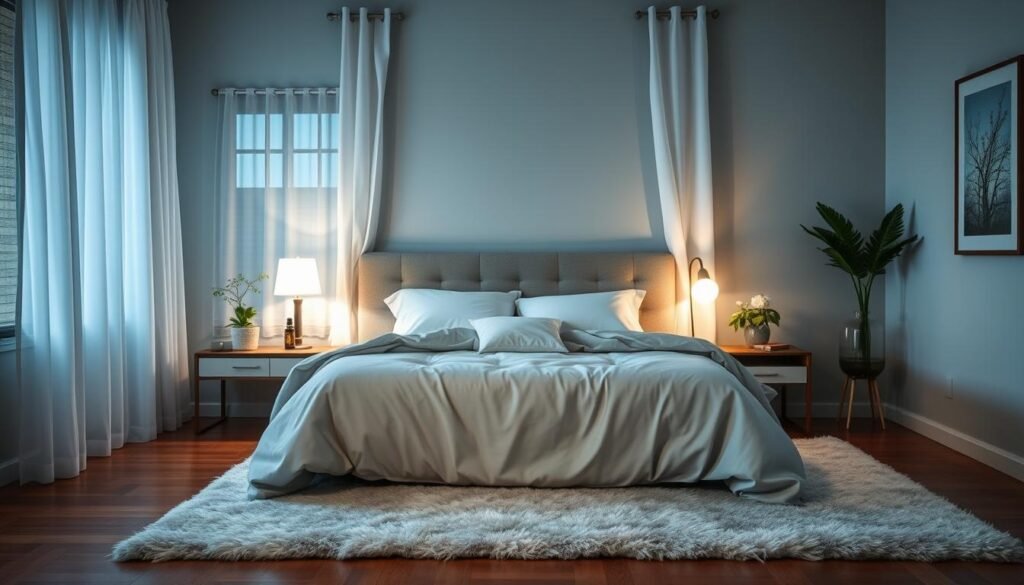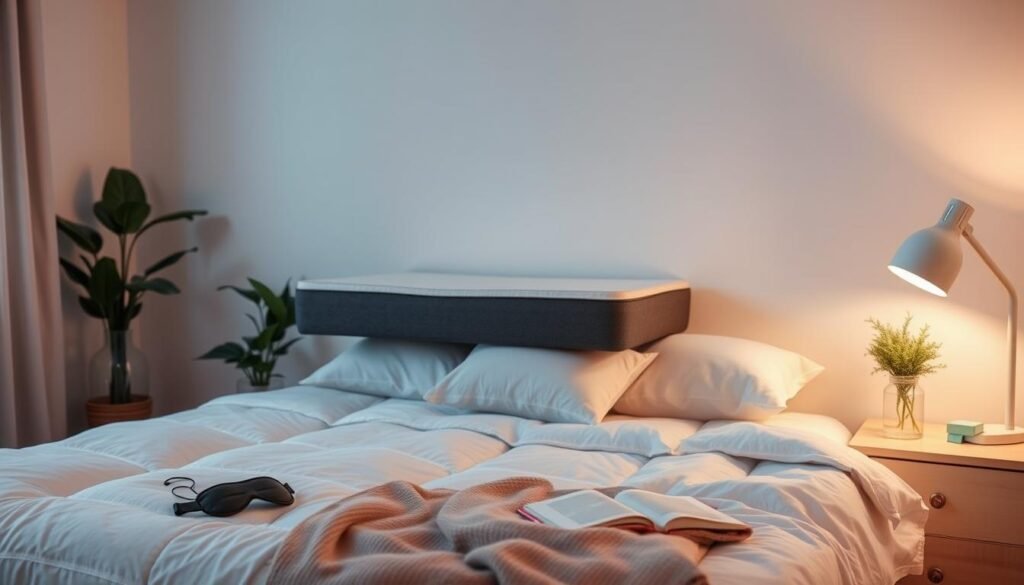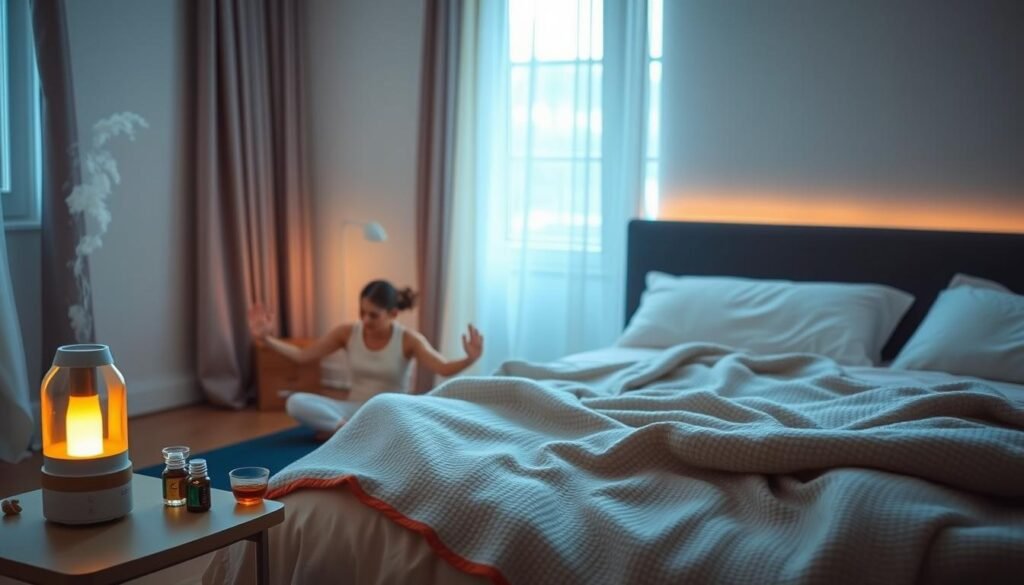More than 80% of people with Postural Orthostatic Tachycardia Syndrome (POTS) experience serious sleep issues. This fact shows a critical, often ignored part of their daily challenges. Insomnia doesn’t just affect their sleep quality but also harms their overall health. In this article, we share important sleep tips specially designed for their needs. Knowing why insomnia happens is key for people with POTS, as they deal with rapid heart rate, tiredness, and pain.
We will look at insomnia strategies next. These include good sleep habits, diet changes, and therapy options. These steps help POTS individuals create a better sleep setting suited to their conditions.
Key Takeaways
- Over 80% of POTS patients report significant sleep disturbances.
- Implementing effective sleep hygiene can vastly improve sleep quality.
- Maintaining a cool room temperature (60-67°F) promotes better sleep.
- Weighted blankets may help individuals with insomnia achieve restful sleep.
- Hydration is crucial for effective management of insomnia and symptoms.
Understanding POTS and Its Connection to Insomnia
POTS affects the autonomic nervous system, causing a rapid heart rate when standing. Symptoms include dizziness and chronic fatigue. Insomnia is common, causing trouble falling and staying asleep.
Chronic fatigue makes it tough to get restful sleep. People often feel too hot or too cold at night. This, and medication side effects, can mess up sleep.
Many wake up often at night due to fluid retention and increased urination. Elevated heart rates make relaxing difficult. Also, pain can prevent finding a comfy sleep position.
To improve sleep, good sleep habits are key. Stress reduction, like meditation, helps. Adjusting medication times with a doctor’s help may reduce sleep problems.
For more on how sleep affects health in POTS patients, see a recent study.
Symptoms of Insomnia in POTS Patients
Many POTS patients struggle with insomnia. They face unique insomnia symptoms that lower their life quality. They have trouble falling asleep and staying asleep. Rapid heart rate, dizziness, and chronic fatigue make relaxation and sleep difficult.
They often wake up during the night. They also feel their sleep isn’t refreshing, leading to tiredness in the day.
POTS patients might also have brain fog. This shows why it’s key to spot sleep disorders early. Insomnia makes POTS symptoms worse. It increases fatigue and makes focusing hard. This creates a hard cycle of insomnia and poor well-being.
It’s important to understand these symptoms to manage them. A sleep journal can help notice issues like stress’s effect on insomnia symptoms. Or how dehydration affects sleep. Fixing these problems can help POTS patients live better. Using good sleep habits and staying hydrated can really help sleep issues.
For more tips on managing insomnia, visit this link.
Causes of Insomnia in People with POTS
A lot of people with POTS, nearly 98.4%, have trouble sleeping. This problem mainly comes from their bodies not regulating sleep well. Another big reason is fatigue because staying upright takes more work for them, which can mess up their sleep.
The meds for POTS also play a role, making it hard to sleep well. POTS patients have a sleep efficiency of only 65.4%, which is quite low. Factors like where you sleep and how you feel mentally also affect this. Pain and trouble falling asleep quickly are common in these patients.
It’s important to tackle what causes this insomnia. This includes focusing on the patient’s overall health, what they eat, and their daily habits. Staying away from certain foods and activities before bed is advised to help improve sleep.
| Factor | Description | Impact on Sleep |
|---|---|---|
| Autonomic Dysregulation | Disrupts natural sleep patterns | Contributes to insomnia and poor sleep quality |
| Chronic Fatigue | Increased effort to remain upright | Leads to disturbances and reduced sleep duration |
| Medications | Side effects from POTS treatments | Affects sleep onset and quality |
| Pain Disturbances | Higher prevalence of pain-related sleep issues | Negatively impacts overall sleep efficiency |
With a better understanding of these insomnia causes, we can help those with POTS. Creating a plan that looks at all aspects of their life can be key to better sleep.
Managing Insomnia in People with POTS
To help POTS patients battle insomnia, we need a plan that betters sleep hygiene and eyes comorbidities. Adding effective habits and understanding other present conditions can make a big difference in sleep quality. This approach is key for improvement.
Implementing Effective Sleep Hygiene Techniques
For folks with sleep issues due to POTS, having strong sleep habits is crucial. Here are some top tips:
- Consistent Sleep Schedule: Sleeping and waking at the same times daily tunes the body’s clock.
- Comfortable Sleep Environment: A good mattress and pillow, plus a cool room (60-67°F), boost relaxation.
- Minimize Stimulants: Less caffeine and screen time before bed can cut down on sleep problems.
- Calming Pre-Sleep Rituals: Doing things like reading or breathing exercises before bed helps calm the body.
Identifying Comorbidities That Impact Sleep
POTS patients often deal with insomnia alongside other issues. Tackling these other problems, like anxiety or depression, can better sleep quality. It’s key to keep an eye on mental health and underlying concerns that worsen sleep troubles. Health experts may suggest specialized therapies or tweak medicines to make sure the treatment hits both POTS and its sleep-related symptoms right on target.
Developing a Consistent Sleep Schedule
A consistent sleep schedule is vital in managing insomnia for people with POTS. It helps regulate the body’s internal clock, boosting sleep quality. Sticking to the same sleeping and waking times every day, even on weekends, improves your sleep-wake cycle.
Having a structured sleep routine helps POTS patients face fewer sleep disruptions. Often, they experience difficulties falling asleep or staying asleep throughout the night. Regular sleep patterns create an ideal environment for restful nights.
Here are some tips for a better sleep schedule:
- Set a specific bedtime and wake-up time to follow daily.
- Avoid significant changes on weekends to maintain rhythm.
- Engage in calming activities before bed to signal the body it’s time to sleep.
- Limit naps during the day to foster better sleep quality at night.
- Keep a daily sleep tracker to identify habits and patterns.
Adjusting the timing of medications can also aid in tackling insomnia for individuals with POTS. Managing medication side effects is crucial as they can interfere with sleep. Discussing personalized strategies with healthcare providers is recommended.
Focusing on a consistent sleep schedule can greatly improve rest quality. This leads to better overall health and daily life performance.
| Tip | Description |
|---|---|
| Set Regular Hours | Stick to the same bedtime and wake-up time every day. |
| Avoid Sudden Changes | Limit sleep time adjustments on weekends to maintain rhythm. |
| Pre-Bedtime Routine | Engage in calming activities like reading or meditating. |
| Restrict Napping | Keep naps short and avoid them late in the day. |
| Utilize a Sleep Tracker | Monitor sleep patterns and habits to identify issues. |
Creating a Sleep-Conducive Environment
Creating a good sleep environment is key for people with POTS. It helps by setting the right temperature, ensuring comfort, and reducing noise. These steps make sleeping much better for them.
Temperature Control and Bedding Comfort
The right room temperature is very important for sleep. For POTS sufferers, a cooler room helps manage symptoms like overheating and fast heartbeats. The best temperatures for sleeping are between 60°F and 67°F.
Adding comfortable bedding also helps. The right mattress and pillows cater to personal comfort needs. This supports better sleep quality.

Reducing Noise and Light Distraction
Noise and light can disrupt sleep big time. Using white noise machines can block out annoying sounds. Blackout curtains or shades make the room dark, promoting deeper sleep.
These steps help make a calm sleeping area. It’s great for getting restful sleep every night.
For extra tips on better sleep, click here.
The Role of Relaxation Techniques in Sleep
Relaxation techniques are key to better sleep, especially for those with insomnia from POTS. Deep breathing helps calm the mind and lower anxiety, making falling asleep easier. Gentle yoga before bed can also ease the body and mind.
Guided imagery takes you to calm places, away from daily stress. It uses peaceful pictures to control racing thoughts, improving sleep. Taking a warm bath at night can help too, by relaxing muscles and preparing the body for sleep.
Using essential oils like lavender or chamomile can make bedtime more relaxing. Aromatherapy boosts the effect of other relaxation methods for better sleep. Here are some effective techniques for a good night’s sleep:
- Deep Breathing Exercises
- Gentle Yoga Stretching
- Guided Imagery Sessions
- Warm Baths Before Bed
- Aromatherapy with Essential Oils
Adding these techniques to your nightly routine can help if you have POTS. They make it easier to fall asleep and enhance nighttime rest. Each method helps make the bedroom a calm spot, making falling asleep smoother and more restful.
Lifestyle Modifications for Better Sleep
Making small changes can really help improve sleep for people with POTS. These can have a big impact in fighting insomnia. Doing gentle exercises and eating differently can help you sleep better and feel healthier.
Integrating Gentle Exercises and Activities
It’s important to exercise for better sleep. Doing easy activities like stretching or taking a short walk can help reduce POTS symptoms. But don’t exercise too close to bedtime. Also, before getting up, tighten and relax your leg muscles a few times. This helps with blood flow and lessens discomfort. These simple movements improve sleep quality.
Adjusting Dietary Habits for Improved Sleep
Changing what you eat can help you sleep better. People with POTS should drink a lot of water, around 2-3 liters every day, and eat more salt, between 3-10 grams or even up to 10-12 grams daily. Eating foods rich in magnesium can help you relax and sleep better. It’s also important to avoid caffeine and nicotine before going to bed. They can stop you from falling asleep.

| Modification Type | Recommendation |
|---|---|
| Hydration | At least 2-3 liters of water per day |
| Sodium Intake | 3-10 grams of sodium daily, up to 10-12 grams if needed |
| Gentle Exercises | Stretching and light walking, avoid before bedtime |
| Avoid Stimulants | No caffeine or nicotine before sleep |
| Muscle Relaxation | Tighten and relax leg muscles before standing |
Medication Management and Sleep Aids
Managing medication is key to treating insomnia for people with Postural Orthostatic Tachycardia Syndrome (POTS). The special nature of POTS can make treating insomnia harder. This is because the condition affects the body’s natural sleep cycle. People with POTS often feel very tired and have trouble sleeping well.
There are several sleep aids that can help improve sleep. Supplements like melatonin can help some people sleep better. There are also prescription medicines like clonidine, which are recommended for POTS patients with high adrenaline. This can aid in better sleep when taken before bed.
It’s vital to know some POTS medicines might make sleep worse. Drugs meant to increase blood pressure, like Midodrine and Droxidopa, might disturb sleep. Sometimes, changing when you take your medicine can help with sleep issues. Seeing your doctor regularly helps tailor your treatment to avoid affecting sleep.
The following table presents comparisons of various medication options:
| Medication | Indication | Potential Impact on Sleep |
|---|---|---|
| Clonidine (Catepres) | Hyperadrenergic POTS | May promote better sleep |
| Pyridostigmine Bromide (Mestinon) | Suspected autonomic neuropathy | Helps manage fatigue, enhancing sleep quality |
| Fludrocortisone (Florinef) | Hypovolemic POTS | Monitor for potential sleep disturbances |
| Midodrine (ProAmatine) | Hypovolemic POTS | Risk of sleep disruption |
| Droxidopa | Hypovolemic POTS | Potential effects on sleep quality |
| DDAVP (Desmopressin acetate) | Water retention | No significant impact on sleep |
Treating insomnia in POTS patients means reviewing and adjusting medications as needed. Talking to a healthcare provider about the best sleep aids and medication plan is crucial. This approach not only tackles insomnia but also promotes overall health in POTS patients.
Alternative Therapies for Insomnia in POTS
Alternative therapies offer a fresh approach to treating insomnia for those with POTS. These methods focus on the psychological and behavioral factors that disturb sleep. Cognitive behavioral therapy for insomnia (CBT-I) is a key method. It changes negative thoughts and actions related to sleep.

Mindfulness is also vital in managing insomnia holistically. It helps with relaxation and reducing stress, important for POTS patients. Practices like meditation, deep breathing, and gentle yoga boost well-being.
Acupuncture is another notable alternative therapy. It shows promise in improving sleep quality for people with sleep issues, including insomnia. It aims to correct energy imbalances and regulate the autonomic nervous system. This could help POTS patients with issues like chronic fatigue.
Looking into these alternative therapies can complement traditional treatments. Together, they provide a well-rounded plan for tackling insomnia in POTS patients. Each method brings unique benefits that can lead to better sleep.
| Alternative Therapy | Description | Potential Benefits |
|---|---|---|
| Cognitive Behavioral Therapy for Insomnia (CBT-I) | Therapy focusing on changing thoughts and behaviors related to sleep. | Improved sleep onset and maintenance; reduced insomnia symptoms. |
| Mindfulness Practices | Techniques for relaxation, such as meditation and yoga. | Lower stress levels; enhanced overall well-being; better sleep quality. |
| Acupuncture | Traditional practice targeting energy balance through needles. | Potential improvement in sleep quality; relaxation of body and mind. |
Conclusion
Managing insomnia for those with POTS needs a well-rounded plan. It’s key to understand how POTS and sleeping problems are linked. Studies show that many with POTS face poor sleep and excessive tiredness during the day.
To better sleep, specific steps like keeping a regular sleep schedule help a lot. Making changes in diet and adding light exercise also improve sleep. It’s important to keep talking with doctors to find what works best.
By knowing the signs and learning how to manage them, people with POTS can sleep better. This improves their life quality. The first step is seeing how vital sleep is for health.